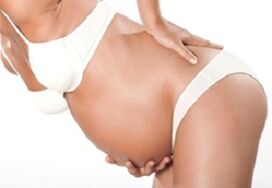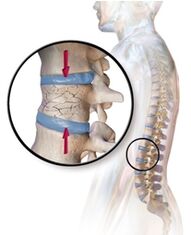Periodic or persistent back pain affects about 80% of the world's population. The problem occurs more often in women. The symptom is called lumbodynia. It is so common due to the constant high stress on the lumbar spine. He experiences pressure from 50 kg (in the supine position) to 220 kg if the person is sitting submerged on the ground. The problem indicates a lifestyle bias or serious illness. With age, it worsens and can lead to disability of the patient.

Physiological causes for pain
Discomfort in the form of pain is the body's protective reaction. So he reacts to various "abnormal" processes inside, which doctors call pathology. The body aches in an uncomfortable position and after a physical exertion, telling the brain that it is difficult for it to perform the tasks.
An uncomfortable position
Low back pain is accompanied by prolonged discomfort. The problem worries drivers and office workers, as they spend a lot of time sitting, when the lower back is exposed to maximum stress. A person has a back pain from fatigue. If he does something for a long time in a bent position.
The back hurts after sleep if the sleeping area is poorly equipped. For example, the bed surface is too hard or soft to provide adequate back support and quality muscle relaxation.
Increased loads
Muscles and ligaments can be injured in the spine. They support the spine in a stable position and are subjected to stress with strenuous physical effort. Conditions for the onset of pain arise with sudden movements, accompanied by muscle tension in the lumbar region. This happens if a person carries weights, pulls heavy objects, lifts them up and down (leaning "in half").
Muscles can also be tensed during sports. If a person exercises a lot, his ligaments need time to recover. If there is no good rest, they are consumed or inflamed, which is signaled by the painful nervous system.
Pain behind women
The problem of low back pain is very common in women, as the beautiful half of humanity experiences them regularly under certain conditions. Menstrual cramps are often accompanied by withdrawal discomfort in the lower back and sacral region. This is not associated with increased stress, but is due to the production of prostaglandins (pain mediators). Before and during menstruation, the synthesis of mediators causes hormonal changes in the female body.
in the female body.
The lower back of girls hurts while holding a baby (in 95% of pregnant women). Not only does the spine experience great stress outside of pregnancy. The pressure in the lower back increases many times as the woman's weight increases. Extra loads are created by the pregnant belly. It pulls the expectant mother’s body forward, changing the axial load distribution. As a result, the woman's gait changes, low back pain occurs, the intensity of which increases in accordance with the duration of pregnancy. Loads increase in any position of the expectant mother, therefore, a good rest, lying on a quality mattress is extremely important to alleviate the condition of the woman.
Hypodynamics
Discomfort often occurs in people who do not engage in sports or remove heavy objects at all. The reason for this is the weakening of the muscular apparatus. The back muscles need to be strong in order to properly support the spine and relieve stress from it. If this does not happen, the bone and cartilage tissue is consumed faster, which is accompanied by pain.
Structural anomalies
The spine is formed by a skeleton of bone tissue - vertebrae. Among them are the soft "layers" of cartilage tissue - vertebral discs. Vertebrae provide strength and endurance, cartilage - flexibility and elasticity of the spine. The main structural elements are hollow in the center. The canal is filled with the spinal cord. All components are surrounded by blood vessels, nerve fibers. Pathologies in any element of the lumbar spine cause lumbodynia.
Osteochondrosis
The disease develops when the intervertebral cartilage discs are consumed. Due to the large loads, the lumbar discs are damaged very often. The most common causes of severe back pain are lengthening (falling) and herniation (damage and lengthening of the discs), in which the nerve roots of the spine are compressed. Osteochondrosis affects people over 35 years old. The disease is especially common in the elderly.
Trauma
The lumbar spine is considered the strongest because it forms the main "axis" for the entire human body. However, with sudden falls and movements, the vertebrae of this section are damaged more often. Most fractures and bruises of the spine are located exactly in the lower back.
Damage to blood vessels
Vessels provide nourishment to all spinal tissues. If their lumen narrows or overlaps, the trophic processes in the spine worsen radically. As a result, inflammation occurs, which always manifests itself in pain.
Nerve capture
Nerve fibers can be damaged due to damage to cartilage and vertebrae, in case of infectious diseases. Any nerve pathology is accompanied by sharp blows and sometimes unbearable back pain.

Bone disorders
Osteoporosis leads to calcium leakage and bone fragility. If the vertebral tissue is depleted, there is an increased risk of serious back injury. In addition, osteoporosis can change the shape of the back bones and increase the pressure on the nerve roots.
Another cause of pain are tumors in the vertebrae. The most common type is hemangioma. These benign neoplasms develop asymptomatically for a long time, but when the tumor becomes too large and extends beyond the vertebra, the patient experiences severe pain.
Inflammatory processes
Arthritis can affect any joint in the body. Inflammation leads to joint damage and pain. It can be provoked by advanced and chronic infectious diseases. Another cause of arthritis is autoimmune connective tissue damage.
Internal problems
The lower back can be damaged not only due to back pathologies. Painful sensations associated with pathology of internal organs or some systemic diseases may be given to the lumbar region.
Internal organs
Back pain is associated with kidney damage. Renal colic is accompanied by sharp and stabbing pain in one or both sides of the back. Most often it is felt just below the ribs in the back of the body.
Lumbar discomfort often occurs against the background of intestinal diseases, with inflammation of the pelvic organs (bladder, prostate - in men, ovaries and uterus - in women).
Systemic pathologies
Psoriasis and ankylosing spondylitis lead to low back pain. With these diseases, violations occur in the structure of connective tissue (cartilage). It loses its elasticity, and therefore often becomes inflamed. Over time, sensitive disturbances in joint function occur, and nerve endings are under constant (damaged) compression. With ankylosing spondylitis, the intervertebral spaces "harden".
Pain in the lower back can cause shingles. Rash with this disease appears on the shoulders, ribs, but more often - on the lateral surfaces of the trunk in the lumbar region. The first pains appear before significant changes in the skin. When a blistering rash appears, the discomfort intensifies, filling with itching. Even after the spots disappear completely, a person still has severe pain along the inflamed nerves. They can bother the patient for several months.
Tumors
Malignant lesions of the spinal cord and bone do not initially change the patient's condition. As the tumor grows and atypical cells spread to the structure of organs and tissues, changes occur in which the nerves are affected. This is manifested by severe pain. Discomfort in the lower back is felt not only with lesions of the lumbar spine, but also if the tumor grows in the internal organs, which are irritated by the nerve ganglia from this department.
Nervous disorders
Lower back pain can be ghostly (in other words, invented by the patient himself). This happens with psychoneurotic disorders. The psyche does not function properly against the background of shocks, stresses, prolonged psycho-emotional stress. Discomfort can arise if a person gets sick on their own, suffers from overload. Such signs appear for the first time after depression or a nervous breakdown and can bother the patient for many years.
How to get rid of back pain
If uncomfortable sensations occur in the lower back, the patient should rest completely, reduce the intensity of the load. As a rule, after a good rest, the discomfort subsides or disappears completely. This is a typical symptom of pain provoked by an improper lifestyle, poor quality rest. If the pain persists, you should consider a visit to the doctor.
The nature of back pain is diagnosed by traumatologists, vertebrologists, orthopedists. You can contact any of the listed specialists. At the first consultation, the doctor will interview the patient, examine him, perform some tests (check the sensitivity of the nerves, the condition of the muscles). If a diagnosis cannot be made based on the information received, an additional examination will be scheduled. To assess the condition of bone tissue, an x-ray is described. The structure of cartilage, nerves, the condition of blood vessels and the spinal cord can be assessed by MRI. If the doctor suspects a systemic disease, the patient is prescribed laboratory diagnosis (general and biochemical tests of blood and urine). Only after making the correct diagnosis will the specialist prescribe treatment.
Drug therapy
The list of drugs depends entirely on the diagnosis. To quickly eliminate the symptoms, the patient will be prescribed a short course of pain relievers (usually from the NSAID group). With severe inflammatory and autoimmune changes, glucocorticoid drugs are prescribed. For cartilage tissue diseases, chondroprotectors are recommended in injections or tablets. If the problem is with the muscles, muscle relaxants are recommended. To restore the work of nerve endings, B vitamins are prescribed.
The main treatment is directed at the cause of the pain. If it is caused by diseases of the internal organs, drug therapy will correct disorders in the functioning of the kidneys, gastrointestinal tract and genitals. The symptoms will disappear as the underlying disease is eliminated. With excruciating pain, a nerve block is performed (analgesics are injected directly into the nerve root areas).
External pain relievers (patches, oils, gels) may be prescribed to increase the effect of injections or tablets. Such drugs can be used independently, with recurrent back pain against a background of increased tension or stress. To alleviate the condition, you can use plaster with pepper or menthol. They are also allowed to be used without a doctor's prescription.
procedures
For low back pain, a specialist may recommend special treatments. These include acupuncture, electrotherapy, ultrasound, therapeutic ultraviolet rays. In some cases, physiotherapy and massage exercises are indicated. If the vertebrae are displaced, the help of a chiropractor may be required to put the bone back in place. Each procedure should be chosen together with a physician. Forbiddens are prohibited from undergoing treatment in which they act directly on the spine without diagnosing the disease. In this case, the procedures can be not only useless, but also harm the patient.
To prevent back pain, you should monitor your back health from a young age. It is important to exercise the load correctly on the back (to lift collected objects, rather than leaning over, pushing heavy objects and not pulling them towards you). You should engage in moderate physical activity and choose exercises with a trainer. It is also important to treat infectious diseases in a timely manner, to avoid stress, to take any reasonable medication and as prescribed by a doctor.












































